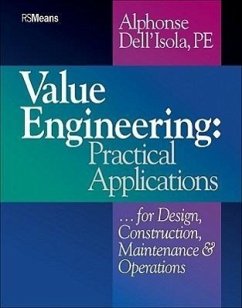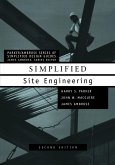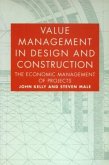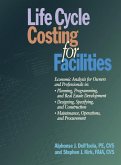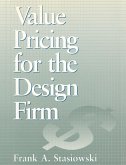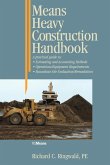Alphonse Dell'Isola
Value Engineering
Practical Applications...for Design, Construction, Maintenance and Operations
Alphonse Dell'Isola
Value Engineering
Practical Applications...for Design, Construction, Maintenance and Operations
- Broschiertes Buch
- Merkliste
- Auf die Merkliste
- Bewerten Bewerten
- Teilen
- Produkt teilen
- Produkterinnerung
- Produkterinnerung
Written by the design and construction industry's most celebrated Value Engineering Practitioner, here is a a complete system for understanding and conducting Value Engineering and Life Cycle Costing Studies--for design, construction, and facilities operation. Along with step-by-step instructional chapters, readers get seven case studies on major facility types, with currently applicable data and examples.
Andere Kunden interessierten sich auch für
![Simplified Site Engineering Simplified Site Engineering]() Harry ParkerSimplified Site Engineering107,99 €
Harry ParkerSimplified Site Engineering107,99 €![Value Management in Design and Construction Value Management in Design and Construction]() John KellyValue Management in Design and Construction69,99 €
John KellyValue Management in Design and Construction69,99 €![Life Cycle Costing for Facilities Life Cycle Costing for Facilities]() Alphonse Dell'IsolaLife Cycle Costing for Facilities118,99 €
Alphonse Dell'IsolaLife Cycle Costing for Facilities118,99 €![Value Pricing for the Design Firm Value Pricing for the Design Firm]() Frank A StasiowskiValue Pricing for the Design Firm96,99 €
Frank A StasiowskiValue Pricing for the Design Firm96,99 €![Means Heavy Construction Handbook Means Heavy Construction Handbook]() Richard C RingwaldMeans Heavy Construction Handbook121,99 €
Richard C RingwaldMeans Heavy Construction Handbook121,99 €![Return or change - Syria Post War Reconstruction Strategy Return or change - Syria Post War Reconstruction Strategy]() Lilas AbdulmawlaReturn or change - Syria Post War Reconstruction Strategy40,99 €
Lilas AbdulmawlaReturn or change - Syria Post War Reconstruction Strategy40,99 €![Big-value Homes Big-value Homes]() Big-value Homes35,99 €
Big-value Homes35,99 €-
-
-
Written by the design and construction industry's most celebrated Value Engineering Practitioner, here is a a complete system for understanding and conducting Value Engineering and Life Cycle Costing Studies--for design, construction, and facilities operation. Along with step-by-step instructional chapters, readers get seven case studies on major facility types, with currently applicable data and examples.
Hinweis: Dieser Artikel kann nur an eine deutsche Lieferadresse ausgeliefert werden.
Hinweis: Dieser Artikel kann nur an eine deutsche Lieferadresse ausgeliefert werden.
Produktdetails
- Produktdetails
- Verlag: Wiley
- Seitenzahl: 464
- Erscheinungstermin: 30. September 1997
- Englisch
- Abmessung: 287mm x 220mm x 37mm
- Gewicht: 1583g
- ISBN-13: 9780876294635
- ISBN-10: 0876294638
- Artikelnr.: 21844157
- Herstellerkennzeichnung
- Libri GmbH
- Europaallee 1
- 36244 Bad Hersfeld
- gpsr@libri.de
- Verlag: Wiley
- Seitenzahl: 464
- Erscheinungstermin: 30. September 1997
- Englisch
- Abmessung: 287mm x 220mm x 37mm
- Gewicht: 1583g
- ISBN-13: 9780876294635
- ISBN-10: 0876294638
- Artikelnr.: 21844157
- Herstellerkennzeichnung
- Libri GmbH
- Europaallee 1
- 36244 Bad Hersfeld
- gpsr@libri.de
Alphonse Dell'Isola, PE, RICS, FCVS, has been working full-time in construction management and value engineering since 1963, conducting over 1,000 contracts for various organizations and agencies on projects totalling more than $50 billion in construction, and resulting in implemented savings of some $3.5 billion. The author has also conducted workshops, seminars, and briefings on value engineering, construction management and project cost control for over 15,000 professionals. Mr. Dell'Isola is currently President of Projacs USA, a consulting firm for project management, value engineering, life cycle costing and cost control. Prior to this position, he served as Director of Value Management for Smith, Hinchman & Grylls, a design firm in Washington, D.C. Mr. Dell'Isola received his engineering degree from the Massachusetts Institute of Technology.
List of Figures.
Preface and Acknowledgements.
About the Author.
Introduction: A Briefing.
The Objectives of Value Engineering.
The Reasons for Unnecessary Costs.
When to Apply Value Engineering.
VE Methodology and Techniques.
InterfaceWith Other Programs.
Demonstrated Impact of VE.
Part One: Value Engineering: Practical Applications.
Chapter One: Project Scope and Budget.
Elements of the Project Budget.
Prevalent Budgeting Techniques.
Cost Control.
Defining Project Scope.
Parameters and Parameter Cost.
Chapter Two: The Capitalized Income Approach to Project Budgeting (CIAPB).
CIAPB Objectives.
Measuring Property Value.
The Meaning of Capitalization.
The Capitalization Process.
The Need for Cost Control.
Chapter Three: Preparation of Cost Models.
Making Models.
Construction Cost Models.
Other Resources.
Types of Models.
Chapter Four: Planning for Value Engineering Services.
VE Objectives.
Level of Effort.
VE and Total Project Management.
Team Selection.
The VE Job Plan.
Chapter Five: Function Analysis.
Classifying Function.
Defining Functions.
Project Level Function Analysis System Techniques (FAST) Diagram.
Chapter Six: Creativity and Interpersonal Skills.
Creativity and Fixation.
Interpersonal Skills.
Human Factors.
Creativity Throughout the Job Plan.
The Generation of Ideas.
Delphi Technique.
Value Engineering-A Crafted Strategy.
Chapter Seven: Life Cycle Costing.
Decision Makers' Impact on LCC.
LCC and Total Building Costs.
LCC Terminology and Examples.
LCC Methodology.
Application of LCC to Buildings.
Chapter Eight: Integrating VE into the Construction Industry.
Planning and Design.
Construction.
Maintenance and Operations (M&O).
Chapter Nine: VE Applications to Risk Assessment and Analysis.
Risk Assessment.
Risk Analysis.
Part Two: Case Studies.
Case Study One: Corporate Office Building.
Case Study Two: Hospital and Staff Housing Complex.
Case Study Three: Refinery Facility.
Case Study Four: Master Planning Competition.
Case Study Five: Application to Design Review Government
Headquarters/Complex.
Case Study Six: Highway Project: South Interchange.
Case Study Seven: Wastewater Treatment Plant.
Part Three: VEWorkbook.
Introduction.
List of Forms.
Phase 1: Information Phase.
Phase 2: Function Phase.
Phase 3: Creative Phase.
Idea Stimulator Checklist.
Phase 4: Analysis/Judicial Phase.
Analysis/Judicial Phase: Analysis/Development.
Analysis/Judicial Phase: Analysis/Evaluation.
Phase 5: Recommendation.
Phase 6: Presentation & Implementation.
Appendix.
Web Site Resources.
Value Engineering Services for CM/PM: Typical Scope ofWork.
Glossary of Terms.
Index.
Part Four: Diskette.
Life Cycle Cost Program with Linked Database.
VEWorkbook Forms with Supporting Linkages.
Preface and Acknowledgements.
About the Author.
Introduction: A Briefing.
The Objectives of Value Engineering.
The Reasons for Unnecessary Costs.
When to Apply Value Engineering.
VE Methodology and Techniques.
InterfaceWith Other Programs.
Demonstrated Impact of VE.
Part One: Value Engineering: Practical Applications.
Chapter One: Project Scope and Budget.
Elements of the Project Budget.
Prevalent Budgeting Techniques.
Cost Control.
Defining Project Scope.
Parameters and Parameter Cost.
Chapter Two: The Capitalized Income Approach to Project Budgeting (CIAPB).
CIAPB Objectives.
Measuring Property Value.
The Meaning of Capitalization.
The Capitalization Process.
The Need for Cost Control.
Chapter Three: Preparation of Cost Models.
Making Models.
Construction Cost Models.
Other Resources.
Types of Models.
Chapter Four: Planning for Value Engineering Services.
VE Objectives.
Level of Effort.
VE and Total Project Management.
Team Selection.
The VE Job Plan.
Chapter Five: Function Analysis.
Classifying Function.
Defining Functions.
Project Level Function Analysis System Techniques (FAST) Diagram.
Chapter Six: Creativity and Interpersonal Skills.
Creativity and Fixation.
Interpersonal Skills.
Human Factors.
Creativity Throughout the Job Plan.
The Generation of Ideas.
Delphi Technique.
Value Engineering-A Crafted Strategy.
Chapter Seven: Life Cycle Costing.
Decision Makers' Impact on LCC.
LCC and Total Building Costs.
LCC Terminology and Examples.
LCC Methodology.
Application of LCC to Buildings.
Chapter Eight: Integrating VE into the Construction Industry.
Planning and Design.
Construction.
Maintenance and Operations (M&O).
Chapter Nine: VE Applications to Risk Assessment and Analysis.
Risk Assessment.
Risk Analysis.
Part Two: Case Studies.
Case Study One: Corporate Office Building.
Case Study Two: Hospital and Staff Housing Complex.
Case Study Three: Refinery Facility.
Case Study Four: Master Planning Competition.
Case Study Five: Application to Design Review Government
Headquarters/Complex.
Case Study Six: Highway Project: South Interchange.
Case Study Seven: Wastewater Treatment Plant.
Part Three: VEWorkbook.
Introduction.
List of Forms.
Phase 1: Information Phase.
Phase 2: Function Phase.
Phase 3: Creative Phase.
Idea Stimulator Checklist.
Phase 4: Analysis/Judicial Phase.
Analysis/Judicial Phase: Analysis/Development.
Analysis/Judicial Phase: Analysis/Evaluation.
Phase 5: Recommendation.
Phase 6: Presentation & Implementation.
Appendix.
Web Site Resources.
Value Engineering Services for CM/PM: Typical Scope ofWork.
Glossary of Terms.
Index.
Part Four: Diskette.
Life Cycle Cost Program with Linked Database.
VEWorkbook Forms with Supporting Linkages.
List of Figures.
Preface and Acknowledgements.
About the Author.
Introduction: A Briefing.
The Objectives of Value Engineering.
The Reasons for Unnecessary Costs.
When to Apply Value Engineering.
VE Methodology and Techniques.
InterfaceWith Other Programs.
Demonstrated Impact of VE.
Part One: Value Engineering: Practical Applications.
Chapter One: Project Scope and Budget.
Elements of the Project Budget.
Prevalent Budgeting Techniques.
Cost Control.
Defining Project Scope.
Parameters and Parameter Cost.
Chapter Two: The Capitalized Income Approach to Project Budgeting (CIAPB).
CIAPB Objectives.
Measuring Property Value.
The Meaning of Capitalization.
The Capitalization Process.
The Need for Cost Control.
Chapter Three: Preparation of Cost Models.
Making Models.
Construction Cost Models.
Other Resources.
Types of Models.
Chapter Four: Planning for Value Engineering Services.
VE Objectives.
Level of Effort.
VE and Total Project Management.
Team Selection.
The VE Job Plan.
Chapter Five: Function Analysis.
Classifying Function.
Defining Functions.
Project Level Function Analysis System Techniques (FAST) Diagram.
Chapter Six: Creativity and Interpersonal Skills.
Creativity and Fixation.
Interpersonal Skills.
Human Factors.
Creativity Throughout the Job Plan.
The Generation of Ideas.
Delphi Technique.
Value Engineering-A Crafted Strategy.
Chapter Seven: Life Cycle Costing.
Decision Makers' Impact on LCC.
LCC and Total Building Costs.
LCC Terminology and Examples.
LCC Methodology.
Application of LCC to Buildings.
Chapter Eight: Integrating VE into the Construction Industry.
Planning and Design.
Construction.
Maintenance and Operations (M&O).
Chapter Nine: VE Applications to Risk Assessment and Analysis.
Risk Assessment.
Risk Analysis.
Part Two: Case Studies.
Case Study One: Corporate Office Building.
Case Study Two: Hospital and Staff Housing Complex.
Case Study Three: Refinery Facility.
Case Study Four: Master Planning Competition.
Case Study Five: Application to Design Review Government
Headquarters/Complex.
Case Study Six: Highway Project: South Interchange.
Case Study Seven: Wastewater Treatment Plant.
Part Three: VEWorkbook.
Introduction.
List of Forms.
Phase 1: Information Phase.
Phase 2: Function Phase.
Phase 3: Creative Phase.
Idea Stimulator Checklist.
Phase 4: Analysis/Judicial Phase.
Analysis/Judicial Phase: Analysis/Development.
Analysis/Judicial Phase: Analysis/Evaluation.
Phase 5: Recommendation.
Phase 6: Presentation & Implementation.
Appendix.
Web Site Resources.
Value Engineering Services for CM/PM: Typical Scope ofWork.
Glossary of Terms.
Index.
Part Four: Diskette.
Life Cycle Cost Program with Linked Database.
VEWorkbook Forms with Supporting Linkages.
Preface and Acknowledgements.
About the Author.
Introduction: A Briefing.
The Objectives of Value Engineering.
The Reasons for Unnecessary Costs.
When to Apply Value Engineering.
VE Methodology and Techniques.
InterfaceWith Other Programs.
Demonstrated Impact of VE.
Part One: Value Engineering: Practical Applications.
Chapter One: Project Scope and Budget.
Elements of the Project Budget.
Prevalent Budgeting Techniques.
Cost Control.
Defining Project Scope.
Parameters and Parameter Cost.
Chapter Two: The Capitalized Income Approach to Project Budgeting (CIAPB).
CIAPB Objectives.
Measuring Property Value.
The Meaning of Capitalization.
The Capitalization Process.
The Need for Cost Control.
Chapter Three: Preparation of Cost Models.
Making Models.
Construction Cost Models.
Other Resources.
Types of Models.
Chapter Four: Planning for Value Engineering Services.
VE Objectives.
Level of Effort.
VE and Total Project Management.
Team Selection.
The VE Job Plan.
Chapter Five: Function Analysis.
Classifying Function.
Defining Functions.
Project Level Function Analysis System Techniques (FAST) Diagram.
Chapter Six: Creativity and Interpersonal Skills.
Creativity and Fixation.
Interpersonal Skills.
Human Factors.
Creativity Throughout the Job Plan.
The Generation of Ideas.
Delphi Technique.
Value Engineering-A Crafted Strategy.
Chapter Seven: Life Cycle Costing.
Decision Makers' Impact on LCC.
LCC and Total Building Costs.
LCC Terminology and Examples.
LCC Methodology.
Application of LCC to Buildings.
Chapter Eight: Integrating VE into the Construction Industry.
Planning and Design.
Construction.
Maintenance and Operations (M&O).
Chapter Nine: VE Applications to Risk Assessment and Analysis.
Risk Assessment.
Risk Analysis.
Part Two: Case Studies.
Case Study One: Corporate Office Building.
Case Study Two: Hospital and Staff Housing Complex.
Case Study Three: Refinery Facility.
Case Study Four: Master Planning Competition.
Case Study Five: Application to Design Review Government
Headquarters/Complex.
Case Study Six: Highway Project: South Interchange.
Case Study Seven: Wastewater Treatment Plant.
Part Three: VEWorkbook.
Introduction.
List of Forms.
Phase 1: Information Phase.
Phase 2: Function Phase.
Phase 3: Creative Phase.
Idea Stimulator Checklist.
Phase 4: Analysis/Judicial Phase.
Analysis/Judicial Phase: Analysis/Development.
Analysis/Judicial Phase: Analysis/Evaluation.
Phase 5: Recommendation.
Phase 6: Presentation & Implementation.
Appendix.
Web Site Resources.
Value Engineering Services for CM/PM: Typical Scope ofWork.
Glossary of Terms.
Index.
Part Four: Diskette.
Life Cycle Cost Program with Linked Database.
VEWorkbook Forms with Supporting Linkages.

